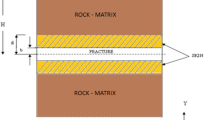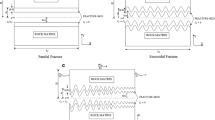Abstract
This study deals with transport of solutes through a saturated sub-surface rock formation with well-defined horizontal parallel fractures. For this purpose, a simplified conceptual model consisting of a single fracture and its associated rock-matrix is considered in the presence of a fracture-skin in order to study the mobility and mixing of solutes along the fracture. In this paper, a coupled fracture-skin-matrix system is modeled numerically using finite difference method in a pseudo two-dimensional domain with a constant continuous source at fracture inlet. Flow and transport processes are considered parallel to the fracture axis, while the transport processes in fracture-skin as well as in rock-matrix are considered perpendicular to the fracture axis. Having obtained the concentration distribution along the fracture, method of spatial moments is employed to study the mobility and spreading of solutes. Sensitivity analyses have been done to understand the effect of various fracture-skin parameters like porosity, thickness, and diffusion coefficient. Further, the influence of non-linear sorption and radioactive decaying of solutes are carried out for different sorption intensities and decay constants. Results suggest that the presence of fracture-skin significantly influences the mobility and spreading of solutes along the fracture in comparison with a coupled fracture-matrix system without fracture-skin.







Similar content being viewed by others
Abbreviations
- b:
-
Half fracture aperture, (L)
- d:
-
Distance from center of fracture to the skin-matrix interface, (L)
- H:
-
Half fracture spacing, (L)
- Cf :
-
Volume concentration of solute in the fracture, (ML−3)
- Cs :
-
Volume concentration of solute in the skin, (ML−3)
- Cm :
-
Volume concentration of solute in the matrix, (ML−3)
- \( C_{s\quad 1}^{n + 1} \) :
-
Volume concentration of the solute at the first node in the fracture skin, (ML−3)
- \( C_{s\quad 2}^{n + 1} \) :
-
Volume concentration of the solute at the second node in the fracture skin, (ML−3)
- C:
-
Volume concentration of solute, (ML−3)
- C0 :
-
Constant concentration for continuous injection of solute source at the inlet of fracture, (ML−3)
- DL :
-
Hydrodynamic dispersion coefficient in the fracture, (L2T−1)
- D* :
-
Free molecular diffusion coefficient of the solute in water, (L2T−1)
- DS :
-
Effective diffusion coefficient in the fracture-skin, (L2T−1)
- Dm :
-
Effective diffusion coefficient in the rock-matrix, (L2T−1)
- Kd :
-
Proportion or distribution coefficient, ((L3M−1)n)
- Kf :
-
Surface sorption coefficient of fracture, (L)
- KS :
-
Volume sorption coefficient of the fracture-skin, (L3M−1)
- Km :
-
Volume sorption coefficient of the rock-matrix, (L3M−1)
- Lf :
-
Length of the fracture along the flow direction, (L)
- n:
-
Freundlich sorption isotherm exponent, (−)
- Rf :
-
Retardation factor of fracture, (−)
- RS :
-
Retardation factor of fracture-skin, (−)
- Rm :
-
Retardation factor of rock-matrix, (−)
- S:
-
Sorbed concentration, (MM−1)
- λ:
-
Radioactive decay constant, (T−1)
- t:
-
Time variable, (T)
- V0 :
-
Mean water velocity in the fracture, (LT−1)
- V(t):
-
Velocity of the solute in the fracture corresponding to time t, (LT−1)
- D(t):
-
Macro-dispersion coefficient in the fracture corresponding to time t, (LT−1)
- x:
-
Space coordinate along the flow direction in the fracture plane, (L)
- y:
-
Space coordinate in the direction normal to the fracture, (L)
- \( \bar{x} \) :
-
Mean distance traveled by a solute front along the fracture, (L)
- α0 :
-
Local fracture dispersivity, (L)
- ρ s :
-
Bulk density of the fracture skin, (ML−3)
- θ s :
-
Fracture-skin porosity, (−)
- ρ m :
-
Bulk density of the rock matrix, (ML−3)
- θ m :
-
Rock-matrix porosity, (−)
- Δy (1):
-
Cell width across the fracture-skin interface, (L)
References
Aris R (1956) On the dispersion of a solute in a fluid flowing through a tube. Proc R Soc A 235:67–77
Banton O, Bangoy LM (1997) Hydrogeologie, multiscience ennvironnmentale des eaux souterraines (Hydrogeology, environmental multiscience of groundwater). Presses de l’Universite du Quebec/AUPELF, Sainte-Foy, Quebec
Becker MW, Shapiro AM (2000) Tracer transport in fractured rock: evidence of non diffusive breakthrough tailing. Water Resour Res 36:1677–1686
Bosma WJP, van der Zee SEATM (1995) Dispersion of a continuously injected, nonlinearly adsorbing solute in chemically or physically heterogeneous porous formations. J Contam Hydrol 18(3):181–198
Bradner GC, Murdoch LC (2005) Effects of skin and hydraulic fractures on SVE wells. J Contam Hydrol 77(4):271–297
Dorn R (1998) Rock coatings. In: Developments in earth surface processes 6. Elsevier, Amsterdam, Lausanne
Driese SG, McKay LD, Penfield CP (2001) Lithologic and pedogenic influences on porosity distribution and groundwater flow in fractured sedimentary saprolite: a new application of environmental sedimentology. J Sedimen Res 71(5):843–857
Ezzedine S, Rubin Y (1997) Analysis of the Cape Cod tracer data. Water Resour Res 33(1):1–11
Fischer HB, List EJ, Koth RCY, Imberger J, Brooks NH (1979) Mixing in inland and coastal waters. Academic Press, New York
Fomin SA, Chugunov VA, Hashida T (2011) Non-Fickian mass transport in fractured porous media. Adv Water Resour 34(2):205–214
Fu L, Milliken KL, Sharp JM Jr (1994) Porosity and permeability variations in the fractured and liesegang-banded Breathitt Sandstone (Middle Pennsylvanian), eastern Kentucky: diagenetic controls and implications for modelling dual porosity systems. J Hydrol 154:351–381
Garner TT, Sharp JM (2004) Hydraulic properties of granitic fracture skins and their effects on solute transport. In: Proceedings, 2004 U.S EPA/NGWA, fractured rock conference: state of the science and measuring success in remediation, national groundwater association, Dublin, Ohio, pp 664–678
Gelhar LW (1993) Stochastic subsurface hydrology. Prentice Hall, Englewood cliffs
Goltz MN, Roberts PV (1987) Using the method of moments to analyze three-dimensional diffusion-limited solute transport from temporal and spatial perspectives. Water Resour Res 23(8):1575–1585
Guven O, Molz FJ, Melville JG (1984) An analysis of dispersion in a stratified aquifer. Water Resour Res 20(10):1337–1354
Himmelsbach T, Hotzl H, Maloszewski P (1998) Solute transport process in a highly permeable fault zone of Lindau fractured rock site (Germany). Groundwater 36(5):792–800
Horn FJM, Kipp RL Jr (1971) Induced transport in pulsating flow. AIChE J 17:621
Kennedey CA, Lennox WC (1995) A control volume model of solute transport in single fracture. Water Resour Res 31(2):313–322
Kreisel I, Sharp JM Jr (1996) Fracture skins in the Brushy Canyon formation. In: DeMis WD, Cole AG (eds) The Brushy Canyon play in outcrop and subsurface: concepts and examples
Landrum MT (2000) Hydrogeologic properties of fracture skins and their effects on radionuclide transport: Thesis (Masters).The University of Texas at Austin
Maloszewski P, Zuber A (1985) On the theory of tracer experiments in fissured rocks with a porous matrix. J Hydrol 79:333–358
Maloszewski P, Zuber A (1990) Mathematical modeling of tracer behavior in short-term tracer experiments and in fissured rocks. Water Resour Res 26:1517–1528
Maloszewski P, Zuber A (1993) Tracer experiments in fractured rocks: matrix diffusion and the validity of models. Water Resour Res 29:2723–2735
Moench AF (1984) Double-porosity models for a fissured groundwater reservoir with fracture skin. Water Resour Res 20:831–846
Moench AF (1995) Convergent radial dispersion in a double-porosity aquifer with fracture skin: analytical solution and application to a field experiment in fractured chalk. Water Resour Res 31:1823–1835
Neretneiks I (1980) Diffusion in the rock matrix: an important factor in radionuclide retardation? J Geophys Res 85(B8):4379–4397
Novakowski KS, Lapcevic PA, Voralek JW, Bickerton G (1995) Preliminary interpretation of tracer experiments conducted in a discrete rock fracture under conditions of natural flow. Geophys Res Lett 22(11):1417–1420
Pasandi M, Samani N, Barry DA (2008) Effect of wellbore storage and finite thickness skin on flow to a partially penetrating well in a phreatic aquifer. Adv Water Resour 31(2):383–398
Phyu T (2002) Transient modeling of contaminant transport in dual porosity media with fracture skins: Thesis (Masters).The University of Texas at Austin
Robinson NI, Sharp JM Jr (1997) Analytical solution for contaminant transport in a finite set of parallel fractures with matrix diffusion. C.S.I.R.O. Mathematical and Information Sciences Report CMIS-C23
Robinson NI, Sharp JM Jr, Kriesel I (1998) Contaminant transport in a set of parallel fractures with fracture skin. J Contam Hydrol 31:83–109
Sanford WE, Cook PG, Dighton JC (2002) Analysis of a vertical dipole tracer test in highly fractured rock. Groundwater 40:535–542
Sharp JM (1993) Fractured aquifers/reservoirs; Approaches, problems, and opportunities. In: Banks D, Banks S (eds) Hydrogeology of Hard Rocks, Memoires of the 24th Cong. International Assoc. Hydrogeologists. Oslo, Norway 24(1):23–38
Sharp JM Jr, Robinson NI, Smyth-Boulton RC, Milliken KL (1995) Fracture skin effects in groundwater transport. In: Rossmanith HP (ed) Mechanics of jointed and faulted rock. A.A. Balkeme, Rotterdam
Suresh Kumar G (2008) Effect of sorption intensities on dispersivity and macro-dispersion coefficient in a single fracture with matrix diffusion. Hydrogeol J (Springer) 16(2):235–249
Taylor GI (1953) Dispersion of soluble matter in solvent flowing slowly through a tube. Proc R Soc A 219:186–203
Weber WJJ, McGinley PM, Katz LE (1991) Sorption phenomena in subsurface system concepts, models and effects on contaminant fate and transport. Water Resour Res 25(5):499–528
Zimmerman MD, Bennett PC, Sharp JM Jr, Choi WJ (2002) Experimental determination of sorption in fractured flow systems. J Contam Hydrol 58:51–77
Acknowledgments
The financial support by Indian Institute of Technology, Madras in New Faculty Scheme with Project No: CIE/07-08/202/NFSC/GSUR is gratefully acknowledged.
Author information
Authors and Affiliations
Corresponding author
Rights and permissions
About this article
Cite this article
Renu, V., Suresh Kumar, G. Numerical Modeling and Spatial Moment Analysis of Solute Mobility and Spreading in a Coupled Fracture-Skin-Matrix System. Geotech Geol Eng 30, 1289–1302 (2012). https://doi.org/10.1007/s10706-012-9540-3
Received:
Accepted:
Published:
Issue Date:
DOI: https://doi.org/10.1007/s10706-012-9540-3




